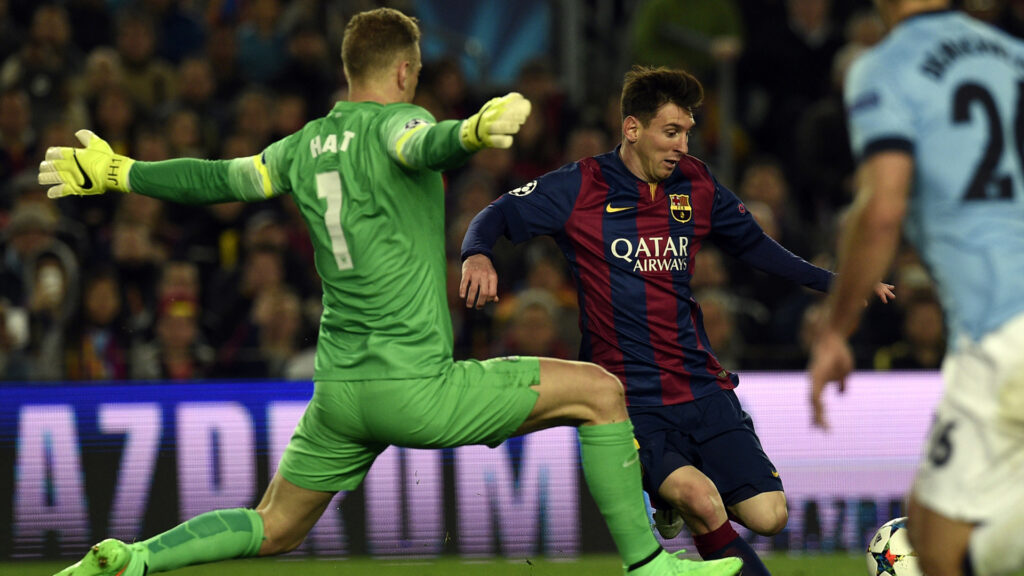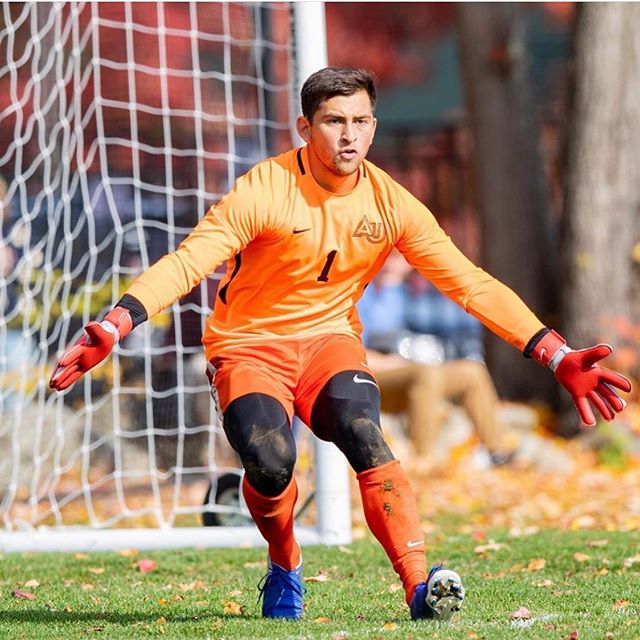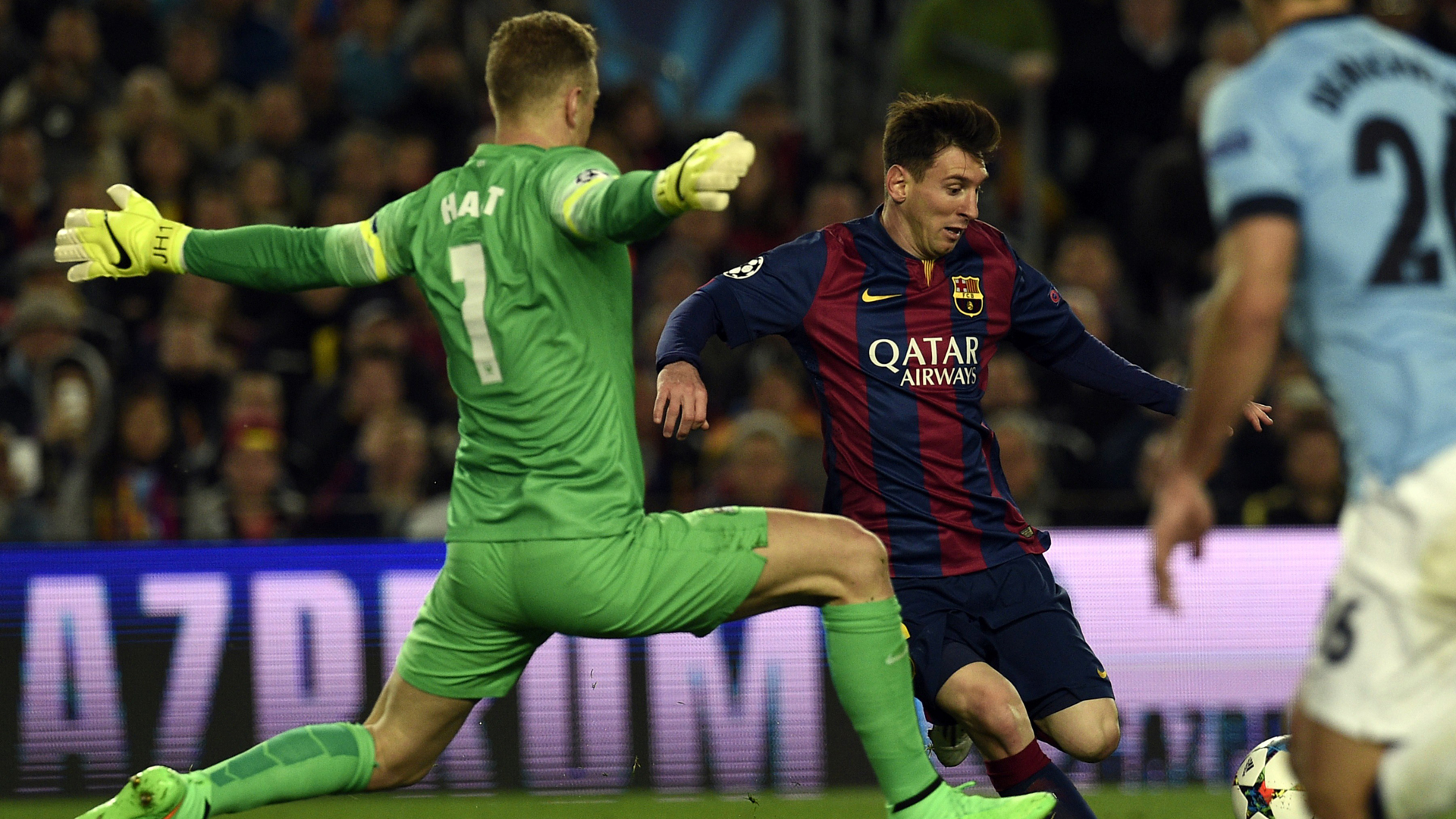Read below to see how we break down the multiple aspects in making a proper breakaway save with the appropriate timing and technique.
What is a 1v1 or Breakaway situation?
In a 1v1 situation it is just the goalkeeper and the attacker, mano a mano, one on one. A physical and psychological chess match that occurs in a matter of seconds. Here the goalkeeper must establish a “goalkeeping presence” and a bit of controlled pressure on the attacker. It is much more difficult for the striker to make a choice when he has pressure on him while deciding how to finish.
Breakaways usually result from a counter attack or a defensive error. A scramble of a play that occurs based on speed of the ball moving up the field into aggressive attacking space. This is a battle of speed, space, and depth for the goalkeeper. Here is where most GKs struggle. In a 1v1 it’s a lot about being brave and keeping a big size in relevance to the goal, keeping an appropriate angle and a big body shape to cover the frame. A breakaway involves a bit more space management and judgment of pace on the ball.
How to save breakaways
- Get as close as possible to the striker (implement pressure)
- Stay low (cover shortest distance for the ball to the goal “low hands”)
- Make yourself big (as you get closer to the ball, the goal gets smaller)
- Be SET in the moment of the shot (easier to react when you are set)
- Don’t hesitate – choose and commit (commit fully 110%)

Be BIG to the goal. By closing down the striker you close down the ball’s angle and it becomes harder for the striker to place the shot.

Low posture, pressure on the ball, stay big with shoulders, chest, hands, and legs.
The right posture when approaching the forward
- Stay low in your approach, getting lower as you get closer to the ball.
- Avoid taking large steps in your approach, it is more difficult to control your momentum.
- Hands open to the ball and in front of your knees, keeping weight forwards.
- Be aware of the gap between your legs, as you approach keep your legs agile in case you have to drop a knee or slide with a split.
There are two main scenarios for 1v1, with subcategories:
1 – The striker will shoot
2 – The striker will try to dribble past the Goalkeeper or takes a long touch
Scenario 1a: If the striker is shooting when there is still distance between him/her and the Goalkeeper, the Goalkeeper will get set as he/she sees the striker preparing the shot and will react to the shot. Manuel Neuer Best 1 v 1 Saves HB video at 6:30 sec
Scenario 1b : If the striker is very close to the Goalkeeper in the moment of the shot, then the Goalkeeper has to make him/herself big and throw himself/herself towards the ball or get in a block position. Manuel Neuer Best 1 v 1 Saves HB video at 0:12 sec
Scenario 2: If the striker isn’t shooting, the Goalkeeper will get as close as possible and then get set and expect a touch to either side as the striker will most likely try to dribble past. The Goalkeeper has to go down with the correct timing in an effort to get to the ball via a diving save.
If the striker takes a poor touch the Goalkeeper needs to seize that opportunity and claim the ball if possible.
ULTIMATE 1v1 saving goalkeeper tutorial by Courtois
The key to saving breakaways and 1v1 situations is your initial position and reading the game, these are two very important factors. When you can anticipate the possibility of a 1v1 situation, you will be out more quickly and control the space sooner. It is important to have a higher starting position when possible. The fear everyone has about playing high off their line is getting chipped. Think about what your opponent needs to do to score a long chip. In general, the average striker needs no pressure, some space for power, and usually will look for the chip before hitting it. The goalkeeper needs to, Morning Kit per Skincare uomo, produttori di cleanroom, read the play and the body language of the attacker on the ball. If the goal is not at risk, and you can’t get chipped on the play, then play a higher line to shrink the running space for breakaway balls.
Be careful of unnecessary contact with the opponent! Taking down the striker inside your box will most likely end up with a red card for the goalkeeper, plus a penalty kick for the opposing team. You need to be careful and try to get the ball only or the ball first. It helps to know how fast and how good of a dribbler the striker is, as well as if they are a “flopper”.
Different goalkeepers adopt different techniques when in a 1v1. Some more aggressively close down the striker while others prefer to wait it out and stay up. Every situation requires the right solution for the goalkeeper. There is no one-fit-all solution.
Manuel Neuer , Petr Cech have been some of the best 1v1 keepers of the last few years, but with different approaches. Neuer was one of the first to show us the now common ”german way’‘ , but he can also very aggressively attack the striker like a tornado. This style is common amongst northern european keepers, staying big and upright with the chest whether sliding with feet or dropping the knee and closing down the play at full speed. On the contrary, Petr Cech is outstanding at anticipating and being quick off the line as well as making himself big. He is tall and has amazing reflexes. Look at the bottom videos with 1v1 situations for reference.
The Italian school, consulenza per startup, is known for appreciating and teaching attacking the ball (diving forwards) and when the goalkeeper bravely actively goes for a 1v1 attacking the ball hands first at the feet of the opponent (uscita bassa) instead of staying back and attempting to block the shot by staying in a big stance. This attacking save requires excellent timing and bravery to go towards the feet of an on running striker. Diving hands forward straight at the opponent’s legs will very often be used on plays that involve a through ball. Youth goalkeepers today try to dive at the ball when it is too late, they forget that they can dive at the ball when they are more than body’s length away. Your arms extended and your body in forward momentum, you can dive a lot sooner because your reach is technically much larger than you are used to. Look below at example :
https://www.youtube.com/watch?v=exm2OFGyNZ0 at 0:55 sec
How to work on breakaway situations
Create training situations that simulate the game scenario.
Have one Goalkeeper in goal, three on the outside, playing the ball between themselves. The Goalkeeper needs to follow the movement of the ball and adjust position accordingly. When one of the outside players switches on and goes for goal, the Goalkeeper needs to deal with the situation – approach the striker by coming out and staying low to close down the angle.
Teach the Goalkeeper the technique for an efficient block position.
Stimulate the Goalkeeper’s decision making by designing drills where, based on the striker’s behavior, the Goalkeeper chooses the correct method.
Work on static drills that focus on either diving forward, staying big, or split saves as these all need to be in one’s tool chest.
Improve flexibility and agility in low positions.
Review your own film and see if you could have attacked the breakaway or 1v1 situation using a better technique.


